Cannabis Heat Stress
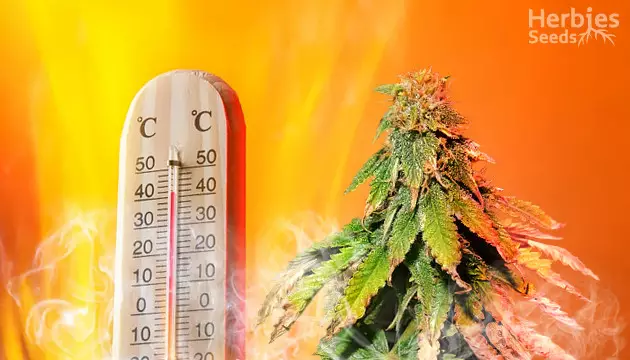
Cannabis heat stress might sound pretty self-explanatory and avoiding it can seem simple, but your cannabis plants can experience many issues – such as discoloration or burning – as a direct result of heat stress. This can have severe implications on the health of your plants as well as the quality and size of your harvest. As you might imagine, this isn’t a pleasant experience, so before you get growing, it’s important to understand the causes of cannabis heat stress, as well as how to prevent it and how to treat it should you find your plants in need of rejuvenation.
What Is Heat Stress?
Cannabis plants, much like other common plants, are only able to withstand a certain amount of heat/light, and a surplus of heat can lead to heat stress and eventually heat burn. While heat stress is bad for your plants, too little heat can likewise have a serious impact on your results, so it’s important to maintain a healthy balance in your grow environment. Your cannabis plants require the right amount of heat from start to finish; indoor plants will excel at a temperature of between 70-75 ˚F during light periods and 50-60 ˚F during dark periods.
Why Is Overheating Dangerous?
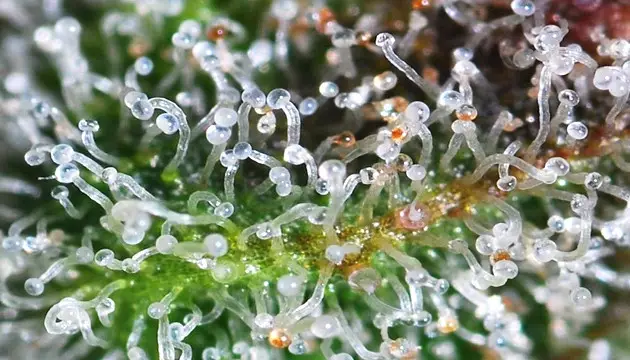
Cannabis heat stress is a common issue that can have a drastic effect that, potentially ruining your plants completely and/or significantly decreasing the quality of your harvest. If your grow space or plants get too warm, this can directly affect the appearance and health of your cannabis. The cannabinoids and terpenoid compounds in cannabis are volatile and rapidly polymerize, so it’s important to keep a cool climate to preserve the full cannabinoid and terpene profile. Furthermore, a natural degradation process occurs toward the end of the grow cycle of cannabis: THC-A to THC. This can be seen visibly as trichomes change color from clear to milky to amber over the harvest window. However, the effects of heat stress can accelerate this process, causing your plants to appear mature and ready for harvest well before they actually are. For this reason, it’s important to ensure that you know how to spot cannabis heat stress. So, what does this look like?
Symptoms Of Overheating
Symptoms of overheating during the flowering stage are different than in vegetation, and the risk associated with heat stress varies with each growth stage too. It’s therefore crucial to understand what these problems are, why they happen and how to prevent them.
A significant sign of overheating is when the tips of the fan leaves begin to dry out and curl upward (also known as “taco”-ing, as the shape of the leaves resembles a taco). When this happens mainly at the top part of the plant, it’s usually a sign that in addition to heat stress, your plants are also experiencing light stress (as the two often occur concurrently).

Here are some other key symptoms that will help you identify cannabis heat stress:
- Leaves starting to look dry and withered.
- Bleaching of leaves at top of plant.
- Leaves developing large brown blotches that form in irregular shapes.
- Yellow patches of discoloration becoming visible (but no physical damage).
- Formation of foxtails – new growth on top of mature buds.
- Leaves looking burned at the tips.
It’s important to correctly identify cannabis heat stress, as there are other issues which can cause similar symptoms (namely, nutrient excess/deficiencies and/or light stress).
How To Prevent Heat Stress
Heat stress among cannabis plants can cause many problems. However, with some patience and effort, you’ll find that there are multiple ways in which you can help your plants withstand higher temperatures or recover from previous heat damage.
Before Grow
One of the best things you can do to prevent heat stress is to grow the right strains for the right climate! For indoor growers, this is less of a concern, as with the right grow space design and appropriate ventilation, ambient temperatures can easily be achieved. For outdoor growers, it’s important to match the genetics and preferences of your strain with your geographical climate.
- Cool climates: Indica/Indica-dominant strains
- Warm climates: Sativa/Sativa-dominant strains
During Grow
The damages of heat stress can be severe, so once spotted, it’s important to tackle this as early as possible to prevent any long-lasting effects. As heat and light issues vary between indoor and outdoor growers, the techniques and equipment you may need will also vary.
Indoors
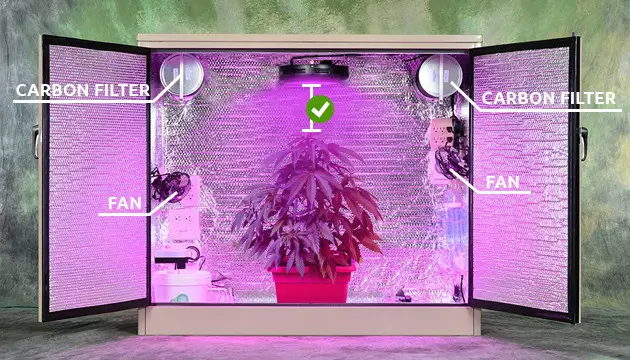
When growing cannabis indoors, it’s ideal to maintain a comfortable room temperature at all times in order to promote rapid growth at a healthy rate. If it’s too hot for you in your growing space, it’s more than likely also too hot for your plants.
Solutions for heat stress among indoor growers mainly consist of increasing the air circulation in your growing area. You can do this by having a small oscillating fan blow over the tops of your cannabis plants, usually coupled with an exhaust system to allow for effective ventilation of the grow space. However, it’s important to note that the use of an exhaust system may also bring about aromas of cannabis in your grow space. For those who wish to operate with more stealth, a carbon filter is a recommended component of the ventilation system to remove any obvious or unpleasant smells. If your plant is experiencing heat problems, you should consider:
- Increasing the distance between your plants and the light source.
- Improving ventilation in your grow space, paired with an oscillating fan to ensure that heat is more evenly spread throughout the grow space.
Outdoors
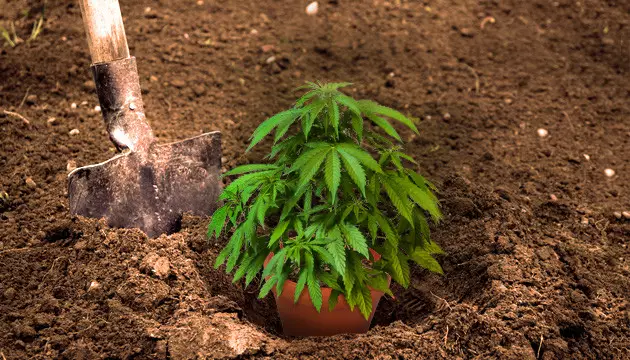
Growing weed outdoors has its fair share of complications when it comes to heat stress, as unlike indoor growers, you aren’t able to tightly control the climate of your grow space. Outdoor growers also have to equally worry about temperatures dropping! Generally speaking, cannabis is a pretty hardy plant that can withstand low temperatures and, as a result of this, outdoor strains can usually withstand temperatures of as low as 50 ˚F without any negative side effects. However, just because they can withstand these low temperatures doesn’t mean it’s practical to make them do so, since plant growth and photosynthesis will occur at a slower rate than it would in warmer temperatures. However, there are some handy tips, tricks and pieces of equipment you can use to prevent heat stress as well as treat it. You may have few to no options to reduce heat during a heatwave, but monitoring local weather via forecasts is recommended to help you prepare – better safe than sorry. If you’re aware that weather conditions are going to be either especially hot or dry, try considering these helpful tips.
- Keep a frequent and thorough watering schedule, as it’s important your plants have enough water, especially over the hotter hours of the day.
- Ensure roots are cool using ceramic pots, which can help insulate the roots from the sun. Growers often dig a hole in the ground to place the potted plant in, this in order to keep the roots from warming up, as the ground is generally much cooler than the exposed air around it.
- Move your plants into a shaded area if exposed to too much heat – an old bed sheet or tarp will work perfectly to remove the majority of any direct sunlight.
How To Fix Damage Caused By Overheating
Damage from overheating is often irreparable, but with the right precautions, its effects can be minimized and your grow still seen through to completion. There are different tricks and pieces of equipment used by indoor and outdoor growers to help tackle the effects of overheating. However, these aren’t universally applicable and don’t apply to each other’s style of growing other than the following tip: use of seaweed kelp extract – a liquid fertilizer that contains many nutrients and minerals. It also contains cytokinins – compounds that are extremely beneficial in the reduction of stress in cannabis plants. This extract helps your plants recover from previous heat stress as well as potentially protecting it from any future instances of heat stress through improved uptake of potassium and antioxidants, both of which help the plant in extreme temperature conditions. This tip especially applies for situations in which the damage has already been done and you want to help your plants recover.
Have you got any tips or tricks of your own for dealing with cannabis heat stress? Let us know in the comments!
***
Cannabis heat stress problems are a common occurrence among cannabis growers both indoors and out, the effects of which can be long-lasting and seriously affect your plants. However, there are plenty of tips and tricks out there, as well as the use of specific pieces of equipment, to help limit the damage from heat stress once it’s already kicked in and can also be used for preventative purposes.
Herbies Head Shop expressly refuses to support the use, production, or supply of illegal substances. For more details read our Legal Disclaimer.


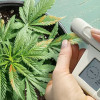


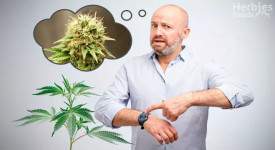


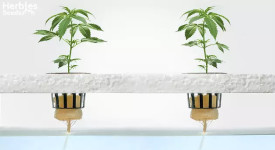
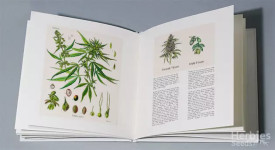

Thank you for leaving a comment for us!
Your feedback will be posted shortly after our moderator checks it.
Please note that we don’t publish reviews that: